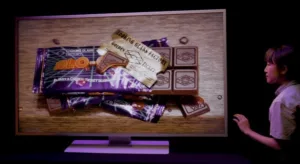Looking Glass Factory, the hologram company, announced the largest, highest resolution holographic display ever created: a groundbreaking 65” 8K display. The new display is in a class of its own: 5x larger than any other 3D holographic display ever demonstrated in the lab by any other company, and 50x larger than any other group-viewable holographic display to ever come to market.
This vast scale makes it ideal for group-viewable uses, such as experiential marketing, 3D storytelling, engineering, and design. The new display is the fourth display in Looking Glass Factory’s growing lineup.
“One of the most frequent questions we get asked is, how large can these displays get?” said Looking Glass CEO, Shawn Frayne. “The answer is now a ridiculously huge 65 inches, and this is only the beginning. Similar to the shift from photographs to film, radio to television, and black & white to color over the past century, the Looking Glass 65” will usher in one of the monumental shifts in how media is consumed, from flat 2D media to deeply 3D. No headset or 3D glasses required.”
The new display is already in use by entertainment companies for both storytelling and marketing. This week, Springbok Entertainment is premiering its new film, entitled Zanzibar: Trouble in Paradise, on the 65” display at the 2022 Tribeca Festival’s immersive program. Zanzibar: Trouble in Paradise is not only the first holographic film or documentary on a Looking Glass display, it is also the first-ever holographic film or documentary in competition at the Tribeca Festival.
“We are thrilled to collaborate with Looking Glass on the premiere of its new and stunning 65-inch 8k holographic display,” said Brandon Zamel, CEO Springbok Entertainment. “The massive increase in the size promises 3D storytellers the ideal canvas to push the boundaries of immersive experiences. This display solidifies the mainstream opportunities and applications of the immersive medium; effectively providing a missing piece of the puzzle for the industry, that in turn, will accelerate its entire growth.”
Product details
The Looking Glass 65” is in a class of its own. This technological marvel delivers unrivaled realism with depth you can genuinely feel, while easy installation and application development tools make operating the Looking Glass 65” effortless.
Only headset-free, 65” holographic display on the market. The new Looking Glass display is the only 65” group-viewable holographic display on the market, making it ideal for showcasing images, scenes, and even entire films. No headset required.
Viewable by groups of 50 people: By generating up to 100 different perspectives of 3D content from 100 million points of light every 60th of a second, the Looking Glass 65” recreates reality with photons. That means everything shown in the Looking Glass 65” feels impossibly real for up to 50 simultaneous viewers.
Highest resolution holographic display: The display’s 8K resolution, color depth of over a billion colors, and 16:9 aspect ratio allow viewers to see the finest details of an image from multiple perspectives.
Impossibly Thin Display. Impossibly Deep Images: Incredibly deep holograms with four times the depth of any other group-viewable system are generated from an impossibly thin 3” slab of glass and aluminum (and a lot of electronics).
Highly Compatible: Works with Looking Glass’s plugins for Unity, Unreal, Blender and other software applications.
About Looking Glass Factory
Looking Glass Factory Inc, with headquarters in Greenpoint, Brooklyn and additional operations in Hong Kong, is the global leader in the field of holographic hardware and software. Their advanced holographic hardware and software is based on the company’s patented light field technology, providing an unparalleled way in which to interact with holograms throughout the fields of 3D creation, both for individual 3D creators and businesses working with 3D — and soon with all of the cross-platform holographic content living in the emerging metaverse. In 2019, Looking Glass interfaces became the most widely adopted holographic displays in history, positioning them to deliver on the long-awaited promise of holograms.

